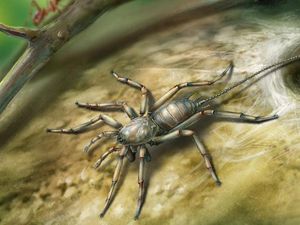Don’t freak out, but scientists have discovered an ancient spider with a tail like a scorpion
The spider has been described as ‘the missing link from older animals and modern spiders’.

An ancient creature that looks like a spider with a scorpion-like tail has been found preserved in 100 million-year-old amber.
The species called Chimerarachne yingi – or chimaera spider – was discovered in northern Burma.
The spider, described as “the missing link from older animals and modern spiders”, has fangs, several legs and silk-producing spinnerets – just like modern spiders.
But unlike any modern living spider, it also has a flagellum or tail that resembles a scorpion’s. Both species belong to the group of eight-legged invertebrates known as arachnids.
The four male specimens preserved in amber are about 2.5mm in body length, excluding the nearly 3mm-long tail.

“It’s for sensing the environment. Animals that have a long whippy tail tend to have it for sensory purposes.”
The team is looking to understand more about what the tiny creature’s day-to-day behaviour would have been like.
Mr Selden said: “We can only speculate that, because it was trapped in amber, we assume it was living on or around tree trunks.
“Amber is fossilised resin, so for a spider to have become trapped, it may well have lived under bark or in the moss at the foot of a tree.”
While the tailed spider was capable of producing silk from its spinnerets, Mr Selden believes they may have not used the silk to create webs to trap bugs.

“However, like all spiders it would have been a carnivore and would have eaten insects, I imagine.”
He believes that because of its remote habitat, tailed descendants of the spider may still be alive in Burma’s rainforest.
He said: “We know a lot about the Burmese biota during the Cretaceous.
“It was a pretty good tropical rainforest, and there are a great many other arachnids we know were there, particularly spiders, that are very similar to the ones you find today in the south-east Asian rainforest.
“It makes us wonder if these may still be alive today.
“We haven’t found them, but some of these forests aren’t that well-studied, and it’s only a tiny creature.”
The research is published in the journal Nature.





